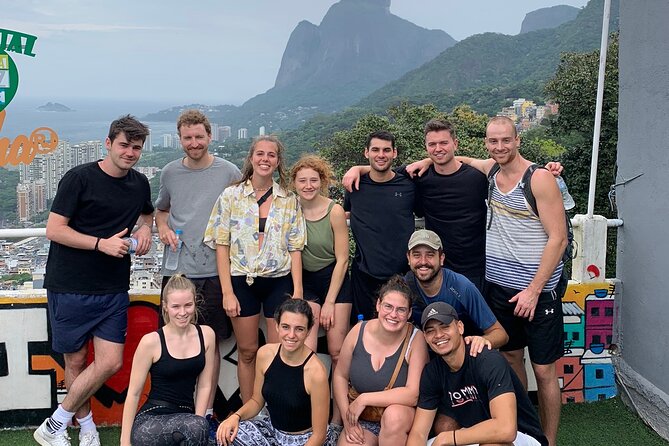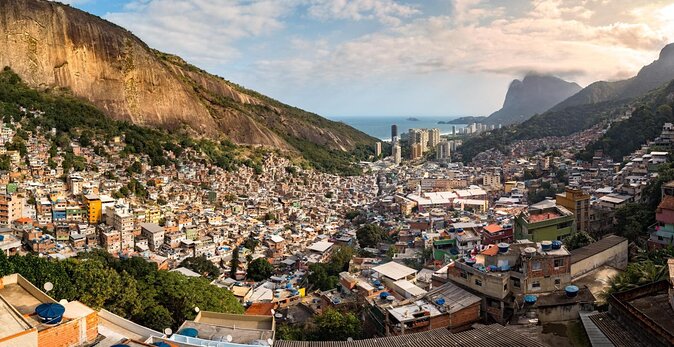Behind the word favela lies a world of resilience, creativity, and community that often goes unnoticed. These vibrant neighborhoods in Brazil, particularly Rio de Janeiro, have been unfairly associated with poverty, crime, and social inequality.
However, the reality is far more nuanced and complex than these stereotypes suggest. Through interviews and firsthand accounts, this discussion aims to uncover the untold stories of favela residents.
From their unique history and daily struggles to the vibrant cultural scene and community initiatives, there is much to learn and appreciate.
By challenging misconceptions and shedding light on the real-life experiences within favelas, this exploration invites readers to see beyond the surface and gain a deeper understanding of these fascinating communities.
Good To Know

- Favelas emerged as a result of rapid urbanization in Brazil and have become symbols of inequality and social exclusion.
- Favelas face socioeconomic challenges such as inadequate access to basic services, high levels of poverty and unemployment, and overcrowded living conditions.
- Despite these challenges, favelas have a vibrant cultural scene, with artistic expression flourishing through colorful murals and lively samba rhythms.
- Community initiatives and empowerment play a crucial role in addressing the challenges faced by favelas, with grassroots movements working to bring about change through education, healthcare, and entrepreneurship opportunities.
History and Origins

The history and origins of the word ‘Favela’ can be traced back to the early 20th century in Brazil. In the historical context of urban development, favelas emerged as informal settlements in response to the rapid urbanization of Brazilian cities. As industrialization and rural-to-urban migration increased, cities faced a housing crisis, leading to the creation of these makeshift communities.
The term ‘favela’ originally referred to a hillside shrub found in the northeastern region of Brazil, but it soon became synonymous with the shanty towns that began to dot the urban landscape. These communities were characterized by their precarious living conditions, lack of basic services, and limited government intervention. Over time, favelas became symbols of inequality and social exclusion, highlighting the stark disparities within Brazilian society.
Despite the challenges they face, favelas have also become vibrant and resilient communities, with a rich cultural heritage that continues to shape Brazil’s urban landscape.
Find more activities and experiences we've covered in Rio de Janeiro.
Socioeconomic Challenges

Socioeconomic challenges in favelas are numerous. These challenges range from inadequate access to basic services to high levels of poverty and unemployment. The favelas, characterized by their makeshift housing and overcrowded conditions, are often plagued by socioeconomic inequality.
Many residents struggle to meet their basic needs, such as clean water, sanitation, and healthcare. Poverty is rampant, with a significant portion of the population living below the poverty line. Unemployment rates are also alarmingly high, making it difficult for residents to secure stable employment and improve their living conditions.
Despite these challenges, efforts have been made to alleviate poverty in favelas. Various organizations and government initiatives have been implemented to provide education, job training, and social programs aimed at empowering residents and improving their socioeconomic status.
However, the road to achieving meaningful change and reducing socioeconomic inequality in favelas remains a complex and ongoing struggle.
Vibrant Cultural Scene
Amidst the socioeconomic challenges that favelas face, a vibrant cultural scene emerges, showcasing the resilience and creativity of its residents. Artistic expression flourishes within these neighborhoods, providing a platform for residents to express their unique stories and perspectives.
From colorful murals adorning the walls to lively samba rhythms echoing through the streets, the favelas become a living canvas of creativity. Artists from all disciplines, whether it be visual arts, music, dance, or theater, find inspiration in the vibrant and diverse culture of the favelas.
This cultural scene not only serves as a form of self-expression but also contributes to the revitalization of the neighborhoods. It brings visitors from all over the world, eager to experience the rich cultural heritage that the favelas have to offer. The artistic vibrancy of the favelas is a testament to the resilience and spirit of its inhabitants.
Community Initiatives and Empowerment
In the favelas, community initiatives and empowerment take center stage, as residents come together to create positive change and uplift their neighborhoods.
Community development is a crucial aspect of life in the favelas, where residents face numerous challenges such as poverty, violence, and lack of basic services.
Grassroots movements have emerged as a powerful force, allowing residents to address these issues and bring about meaningful change. These initiatives range from education and healthcare programs to environmental sustainability projects and entrepreneurship opportunities.
Through these efforts, residents aren’t only improving their own lives but also creating a sense of unity and pride within their communities.
Misconceptions and Stereotypes
As the favelas strive to create positive change and uplift their communities, it becomes evident that misconceptions and stereotypes often overshadow the reality of life within these vibrant neighborhoods.
Challenging stereotypes, the favela residents are actively working towards empowering their communities and changing public perceptions. Contrary to popular belief, favelas aren’t just places of poverty and violence. They’re filled with resilient individuals who are striving for a better future.
Community initiatives such as education programs, art projects, and entrepreneurship are flourishing in these areas. The favela residents are reclaiming their narratives and sharing their stories to challenge the negative stereotypes that have been perpetuated for years.
- Paragliding or Hang Gliding Included Pick up and Drop off From Your Hotel.
- Favela Tour in Rocinha With Transfer
- Tijuca Forest Half-Day Hike (Small Group or Private)
- Ginga Tropical – Brazilian Samba and Folklore Show
- Full Day Private Tour – Rio De Janeiro Highlights by Bernard Moraes
- Private and Customized City Tour of Rio De Janeiro
Impact of Tourism
Tourism in the favelas has had a profound impact on both the local economy and the perception of these vibrant communities. The positive effects of tourism can be seen in the increased job opportunities and income for local residents. Many favela residents have started their own businesses, such as guesthouses, restaurants, and tour guides, to cater to the growing number of travelers. This hasn’t only boosted the local economy but also empowered the community by providing them with a means of self-sustainability.
On top of that, sustainable tourism practices have been implemented to ensure that the favelas can benefit from tourism in a responsible and environmentally-friendly manner. Community-based tourism initiatives have been established, allowing travelers to engage with the local culture and contribute to the development of the favelas. This has helped in breaking down stereotypes and misconceptions surrounding these communities, as travelers get to experience the warmth and hospitality of the residents firsthand.
Future Outlook and Challenges
Despite the positive impact of tourism in the favelas, there are still future challenges that need to be addressed. The future development and social integration of these communities are crucial for their long-term sustainability. Here are some of the challenges that lie ahead:
Infrastructure: Many favelas lack proper infrastructure, including reliable water and sanitation systems, roads, and public transportation. Future development efforts should focus on improving these basic amenities to enhance the quality of life for residents.
Education: Access to quality education is vital for the future of favela communities. Efforts should be made to improve educational facilities, provide adequate resources, and support programs that promote learning and skill development.
Employment Opportunities: Creating sustainable job opportunities within the favelas is essential for economic growth and social integration. Initiatives should focus on promoting entrepreneurship, vocational training, and attracting businesses to invest in these communities.
Security: Addressing the issue of violence and crime is crucial for the future development of favelas. Collaborative efforts between the government, local authorities, and residents should be undertaken to ensure the safety and well-being of the community.
Social Stigma: Overcoming the negative stereotypes associated with favelas is necessary for their social integration. Promoting cultural exchange and breaking down barriers can help foster understanding and acceptance between favela communities and the wider society.
Common Questions
How Did the Term "Favela" Come About and What Is Its Historical Significance?
The term ‘favela’ originated in the late 19th century in Rio de Janeiro, Brazil. It initially referred to a type of plant. Over time, it became associated with the informal settlements that emerged in the city, symbolizing poverty and inequality. The significance of ‘favela’ lies in its historical connection to the marginalized communities and the negative stereotypes that have shaped the lives of its residents.
What Are the Main Socioeconomic Challenges Faced by Favela Residents on a Daily Basis?
Favela residents face daily challenges including safety concerns and limited access to basic services. These issues impact their overall socioeconomic well-being, making it difficult to escape the cycle of poverty and improve their quality of life.
How Has the Vibrant Cultural Scene Within Favelas Contributed to Their Overall Identity?
The vibrant cultural scene within favelas has contributed to their overall identity through cultural resilience and artistic expression. Despite facing socioeconomic challenges, favela residents have found ways to showcase their unique cultural heritage and creativity.
What Are Some Notable Community Initiatives and Empowerment Programs That Have Been Implemented in Favelas?
Community engagement and youth empowerment are key focuses of notable initiatives in favelas. These programs aim to uplift residents by providing education, vocational training, and support networks, fostering a sense of pride and empowerment within the community.
What Are Some Common Misconceptions and Stereotypes About Favelas and How Do They Impact the Residents’ Lives?
Common misconceptions and stereotypes about favelas have significant consequences on the lives of residents. These false beliefs can perpetuate stigmatization, hinder social and economic opportunities, and reinforce inequality, making it harder for residents to overcome challenges and improve their quality of life.
The Sum Up
To sum it up, the world of favelas is far more complex and vibrant than the stereotypes often suggest.
These communities have a rich history, face significant socioeconomic challenges, and yet possess a thriving cultural scene and a strong sense of community.
By challenging misconceptions and shedding light on the daily struggles and triumphs of the residents, we can foster a deeper understanding and appreciation for the resilience and creativity that exists within these neighborhoods.
Despite the challenges ahead, the future of favelas holds the potential for positive change and empowerment.
More Tour Reviews in Rio de Janeiro
Looking for something different? Other Rio de Janeiro activities we've written about
- Rio de Janeiro: Wake Up and Sail
- From Rio de Janeiro: Arraial do Cabo Island Day Trip
- Petropolis the Imperial City With Beer Tour and Lunch
- 25 Best Guided Tours in Rio De Janeiro
- 9 Best Shopping Tours in Rio De Janeiro
- 25 Best Tours in Rio De Janeiro
- 10 Best Sailing Experiences in Rio De Janeiro
- 20 Best Historical Tours in Rio De Janeiro
- 17 Best Workshops and Classes in Rio De Janeiro
- 4 Best 3 Day Tours in Rio De Janeiro
- 3 Best 2 Day Tours in Rio De Janeiro
- 25 Best Boat Tours and Cruises in Rio De Janeiro
